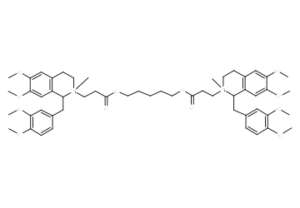Atracurium Besylate CAS NO 64228-81-5 Inquire about Atracurium Besylate
Tecoland supplies Atracurium Besylate bulk active pharmaceutical ingredient (API) to the pharmaceutical industry. Our Atracurium Besylate is manufactured by cGMP compliant facility. Welcome to contact us for further details including current DMF status for the product and up to date regulatory status of the manufacturing facility. We look forward to assisting you with your research and development projects.
What is Atracurium Besylate?
Atracurium Besylate is a synthetic, non-depolarizing neuromuscular blocking agent. Atracurium, is a bisquaternary, non-choline diester structurally similar to metocurine and tubocurarine.
Atracurium Besylate is an intermediate-duration, nondepolarizing, skeletal muscle relaxant for intravenous administration. It has a molecular weight of 1243.51, and its molecular formula is C65H82N2O18S2.
What is Atracurium Besylate used for?
Atracurium is indicated as an adjunct to general anesthesia to produce muscle relaxation during surgical procedures or mechanical ventilation and also to facilitate endotracheal intubation. Atracurium can be used in patients with significant renal or hepatic disease.
Atracurium Besylate is a complex molecule containing four sites at which different stereochemical configurations can occur. The symmetry of the molecule, however, results in only ten, instead of sixteen, possible different isomers. The manufacture of Atracurium Besylate results in these isomers being produced in unequal amounts but with a consistent ratio. Those molecules in which the methyl group attached to the quaternary nitrogen projects on the opposite side to the adjacent substituted-benzyl moiety predominate by approximately 3:1.
Atracurium Besylate Pharmacokinetics
After IV injection, maximal neuromuscular blockade generally occurs within 3-5 minutes. The duration of maximal blockade increases as the dosage increases. Systemic alkalosis may diminish the degree and duration of blockade; acidosis potentiates it. In conjunction with balanced anesthesia, the duration of blockade generally persists for 20-35 minutes. Recovery times do not change after maintenance doses are given, so predictable blocking effects can be attained when the drug is administered at regular intervals.
Atracurium is metabolized by ester hydrolysis and Hofmann elimination which occurs independently of renal or hepatic function.
Atracurium Besylate Drug Interaction
The following agents may enhance the neuromuscular blocking activity of atracurium: procainamide, quinidine, verapamil, aminoglycoside antibiotics, lincomycin, clindamycin, bacitracin, polymyxin B, lithium, magnesium sulfate, thiazide diuretics, enflurane, isoflurane, and halothane. Loop diuretics have been reported to both decrease and increase the effects of nondepolarizing neuromuscular blockers. Other muscle relaxant drugs may cause a synergistic or antagonistic effect. Succinylcholine may speed the onset of action and enhance the neuromuscular blocking actions of atracurium. Do not give atracurium until succinylcholine effects have diminished. Theophylline or phenytoin may inhibit or reverse the neuromuscular blocking action of atracurium.
Precautions Before Using Atracurium Besylate
Atracurium is contraindicated in patients who are hypersensitive to it. Because it may rarely cause significant release of histamine it should be used with caution in patients where this would be hazardous (severe cardiovascular disease, asthma, etc.). Atracurium has minimal cardiac effects and will not counteract the bradycardia or vagal stimulation induced by other agents. Use of neuromuscular blocking agents must be done with extreme caution, or not at all, in patients suffering from myasthenia gravis. Atracurium has no analgesic or sedative/anesthetic actions.
Atracurium Besylate side effects
Clinically significant adverse effects are apparently quite rare in patients (<1% in humans) receiving recommended doses of atracurium and usually are secondary to histamine release. They can include: allergic reactions, inadequate or prolonged block, hypotension vasodilatation, bradycardia, tachycardia, dyspnea, broncho-, laryngospasm, rash, urticaria, and a reaction at the injection site. Patients developing hypotension usually have preexisting severe cardiovascular disease.
Overdose Atracurium Besylate
Overdosage possibilities can be minimized by monitoring muscle twitch response to peripheral nerve stimulation. Increased risks of hypotension and histamine release occur with overdoses, as well as prolonged duration of muscle blockade.
Atracurium Besylate Storage
Atracurium injection should be stored in the refrigerator and protected against freezing. At room temperature, approximately 5% potency loss occurs each month; when refrigerated, a 6% potency loss occurs over a year time.
Disclaimer:
Information on this page is provided for general information purposes. You should not make a clinical treatment decision based on information contained in this page without consulting other references including the package insert of the drug, textbooks and where relevant, expert opinion. We cannot be held responsible for any errors you make in administering drugs mentioned on this page, nor for use of any erroneous information contained on this page.